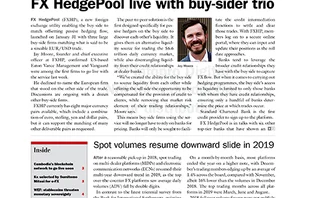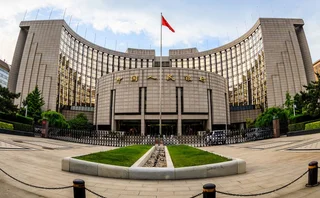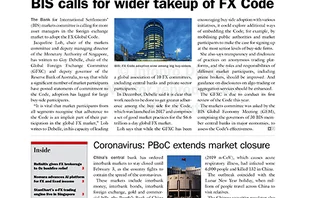
First Ibor versus SOFR cross-currency swaps trades
Westpac and Citi strike BBSW/SOFR trade in landmark moment for Australian market

Westpac and Citi have struck what is believed to be the first cross-currency swap referencing an unsecured Ibor and the US secured overnight financing rate, in a trade that also breaks ground in an important market for Australian financial institutions.
The $325 million one-year swap was struck on December 10 New York time and references SOFR on the US dollar leg and Australia’s bank bill swap rate, or BBSW, on the Australian dollar leg. The transaction was designed to swap a SOFR note issuance by Westpac back into the local currency.
Australian banks source a large portion of their funding from US credit markets and need to swap the funds back into the local currency, which means cross-currency swaps are in high demand.
Libor rates across five currencies, including US dollar, will continue publication until at least the end of 2021. At that point, the UK Financial Conduct Authority will give up its power to compel banks to submit quotes to the various panels, after which the rates are in danger of ceasing.
Ahead of this, financial institutions have looked to issue US dollar floating rate notes against the currency’s Libor replacement, SOFR. But given SOFR swap liquidity is still patchy, Citi and Westpac had to use Libor as a base to price the US dollar leg of the trade.
“The way it gets calculated in bank systems as they’re transitioning across to SOFR is intermediating Libor – a SOFR to Libor calculation then a Libor to BBSW in the background,” says Michael Gordon, a director in the global markets division at Citi’s Sydney office. “As Libor gets replaced, it’ll just be straight SOFR to BBSW. We’re currently in that transition phase.”
The credit-based BBSW has been reformed in recent years, moving it away from a submission calculation model similar to Libor’s and towards a calculation based on a more robust set of transactions. The Reserve Bank of Australia (RBA) has said derivatives can remain linked to the BBSW while some floating rate notes should move towards the designated alternative risk-free rate (RFR), the Australian interbank overnight cash rate (Aonia).
The Australian dollar market is expected to continue as a multiple rate regime
Greg Kaspar, Westpac
But while Aonia is seen as a better liability match for loan assets, and would see compounded, backward-looking overnight rates used on both legs of the swap, BBSW is the more liquid benchmark.
“The Australian dollar market is expected to continue as a multiple rate regime, which provided comfort that the incumbent index BBSW was appropriate on the AUD leg,” says Greg Kaspar, an executive director in the Westpac group treasury’s chief investment office.
Hedge opportunity
RBA deputy governor Guy Debelle has said in the past that the choice of rate used in the cross-currency swap market may dictate whether banks use Aonia for their own Australian dollar floating rate note issuance. Ultimately, this could then see Aonia used in the swaps to hedge the notes.
Citi’s Gordon, however, says the Australian market is likely to stick with the BBSW for now: “It wouldn’t be surprising in the next few years [if] Australia starts to move in the same direction as the rest of the world. However, we don’t see that Australia is going to switch to an overnight secured rate of some form as fast as the US or Europe,” he says.
The SOFR/BBSW trade comes shortly after the first cross-currency swaps referencing two new risk-free rates traded, as well as a pair of two-year, $13 million SOFR/Sonia swaps, according to the Depository Trust & Clearing Corporation’s (DTCC) swap repository (see table A).
Goldman Sachs and JP Morgan were counterparties on one of the SOFR/Sonia swaps, Risk.net understands.
Of course, the RFR-linked cross-currency swap market is still in its early days. In comparison, November cross-currency basis swap trades reported to the DTCC, where both legs are linked to Libor for the dollar-sterling and dollar-euro pairings, totalled $74 billion and $93 billion in notional value, respectively.
Cross-currency basis swap trading in November referencing BBSW and US dollar Libor and reported to the DTCC totalled $28 billion.
Only users who have a paid subscription or are part of a corporate subscription are able to print or copy content.
To access these options, along with all other subscription benefits, please contact customer services - www.fx-markets.com/static/contact-us, or view our subscription options here: https://subscriptions.fx-markets.com/subscribe
You are currently unable to print this content. Please contact customer services - www.fx-markets.com/static/contact-us to find out more.
You are currently unable to copy this content. Please contact info@fx-markets.com to find out more.
Copyright Infopro Digital Limited. All rights reserved.
As outlined in our terms and conditions, https://www.infopro-digital.com/terms-and-conditions/subscriptions/ (point 2.4), printing is limited to a single copy.
If you would like to purchase additional rights please email info@fx-markets.com
Copyright Infopro Digital Limited. All rights reserved.
You may share this content using our article tools. As outlined in our terms and conditions, https://www.infopro-digital.com/terms-and-conditions/subscriptions/ (clause 2.4), an Authorised User may only make one copy of the materials for their own personal use. You must also comply with the restrictions in clause 2.5.
If you would like to purchase additional rights please email info@fx-markets.com
More on Foreign Exchange
Average reported daily UK FX turnover hits record high
Daily turnover of $2,881bn in October 2019, up 2% from previous high of $2,821bn in April
PBoC injects 1.2 trillion yuan as markets plunge
Chinese central bank eases to support economy as coronavirus spreads; Q1 GDP growth could drop to 4%
Spot volumes on platforms resumed downward trend in 2019
But an uptick was seen in FX swaps and forwards submitted for settlement
PBoC extends market closure as coronavirus spreads rapidly
Chinese central bank extends interbank markets closure and vows to maintain ample liquidity








